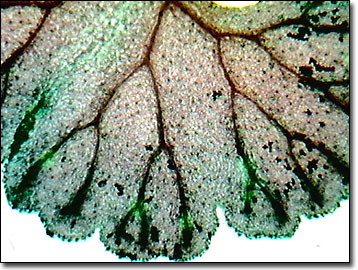Brightfield Digital Image Gallery
Fern Sporophyte
Fern is a common name for the cryptogamous (spore-producing) plants belonging to the division Filicophyta, also called Filicinophyta or Pterophyta of seedless vascular plants. They are primitive vascular plants with true roots, stems, and complex leaves. Most ferns reproduce by alternating generations between successive asexual and sexual forms.

The sexual form, called the gametophyte or prothallium, is a tiny kidney-shaped haploid (N) plant that is difficult to find in the wild. The asexual form, or sporophyte form, is represented by the fern plant as it is commonly known and is diploid (2N). Sporophytes can reproduce either by vegetative cloning via their rhizomes or through spore formation via meiosis. Spores, rather than gametes, are the unicellular, haploid products of meiosis in fern plants. Spores in turn undergo mitotic cell divisions to produce the multicellular, haploid gametophyte. Relative to the familiar sporophytes, the fern gametophytes are small and inconspicuous.
Commonly in primitive vascular plants, the haploid gametophyte phase occurs in a manner that allows it to be surrounded by tissues of the parent sporophyte, such as within cones, seeds, or pollen grains. Unlike some other non-flowering vascular plants, ferns produce one type of spore (homosporous) via meiosis in the sac-like sporangia. Within each sporangium, the diploid spores (spore mother cells or sporocytes) undergo meiosis. Clusters of sporangia (sorus) compose the typical "brown spots" that are often observed on the underside of fern fronds.
The Filicophyta division is diverse, containing about 150 genera and as many as 15,000 species. Fern fossils have been dated to the Lower Devonian Period, 360 million years ago, making them among the oldest vascular plants. Ferns occur throughout the world, but are most profuse in tropical regions where some species grow as epiphytes (air plants) on the trunks and branches of trees. The number and diversity of ferns diminishes with increasing latitude and decreasing moisture, though a few species are found in dry, cold regions.
Contributing Authors
Cynthia D. Kelly, Thomas J. Fellers and Michael W. Davidson - National High Magnetic Field Laboratory, 1800 East Paul Dirac Dr., The Florida State University, Tallahassee, Florida, 32310.
BACK TO THE BRIGHTFIELD IMAGE GALLERY
BACK TO THE DIGITAL IMAGE GALLERIES
Questions or comments? Send us an email.
© 1995-2025 by Michael W. Davidson and The Florida State University. All Rights Reserved. No images, graphics, software, scripts, or applets may be reproduced or used in any manner without permission from the copyright holders. Use of this website means you agree to all of the Legal Terms and Conditions set forth by the owners.
This website is maintained by our
Graphics & Web Programming Team
in collaboration with Optical Microscopy at the
National High Magnetic Field Laboratory.
Last Modification Friday, Nov 13, 2015 at 01:19 PM
Access Count Since September 17, 2002: 27383
Visit the website of our partner in introductory microscopy education:
|
|
